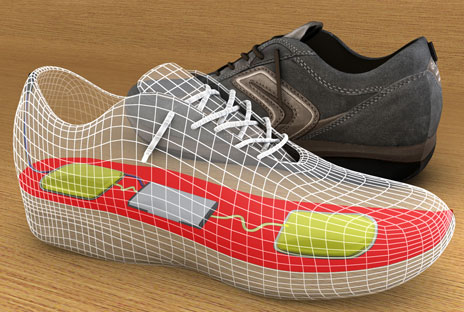Now charge your mobile batteries from shoes charger
shoes charger – New tech could power portable gadgets with every step
In future it may be possible that your shoes will also work as a battery charger of your mobile or any other gadgets ( shoes charger).
Developers are working on it and it may be possible that these shoes will be available in next 1-2 years.
As smartphones and other portable gadgets push the limits of handheld computing, their hunger for electricity has only increased—with no end in sight. A new technology aims to address this issue, not by seeking bigger and better batteries but by looking instead to the shoes on our feet.
When we walk, our bodies create up to 40 watts of mechanical power as heat when our feet strike the ground. A special electricity-generating cushion placed inside the soles of a regular pair of shoes can transform some of that footfall power into several watts of electricity. Over the course of a single day, the generated energy, which gets stored in a small battery in the sole, provides enough electricity for a pedestrian to extend her smartphone’s battery life, for a soldier to augment his portable power needs in the field, or for someone in a developing nation without an electrical grid to power a night’s worth of LED home light use.
The idea of harvesting body energy for portable electronics is certainly not new, although some of this technology is. In 1996, Thad Starner at the MIT Media Lab that piezoelectric generators—solids that generate tiny currents when stretched or stressed—could theoretically generate up to 5 W of electricity at a brisk walking pace.
Today’s best known piezoelectric footwear—Nike+ running shoes—aren’t really harvesting energy at all.
According to Tom Krupenkin, associate professor of mechanical engineering at the University of Wisconsin–Madisonthe liquid metals such as mercury and Galinstan, a gallium indium tin alloy when set on a dielectric-coated conductive substrate with a voltage applied across it, a droplet of liquid metal deforms and spreads across the substrate. When the process is reversed, and the liquid metal in a micro fluid device is moved, it induces a voltage.
According to Krupenkin, InStep is developing a shoe sole that would store the energy from each footfall in an embedded battery. InStep says it would provide up to 10 W from each foot—enough to power a mini Wi-Fi hot spot that communicates with your smartphone via Bluetooth and handles the phone’s biggest battery-draining function: long-range communication with cellphone towers.
Resource : IEEE.ORG
You may also like to see-
How to save your android mobile tablet battery life without any special apps
